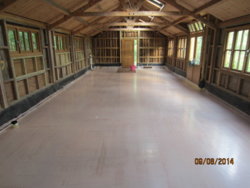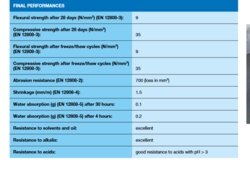R
Richard Head
Good morning, Gents
I'd really appreciate the advice of experienced members here. I've been doing a small barn conversion in Kent for myself for the past 7 years and it's still nowhere near complete. I think I probably have OCD and this is only getting worse.
The footprint of the building is rectangular and 15 x 5m. An anhydrite screed was pumped in over wet UFH in August 2014. The laitance was removed with an orbital floor sander about a week later and the finish is near perfect. Expansion strips were provided around the perimeter only. It has been subject to only light wear and tear since and got splattered with water when the place got plastered out a month ago. I'm pretty damn sure it's now dry as a bone.
There are some stud partitions which are built off the screed so the screed is effectively one big slab which can expand and contract freely. The UFH has only just been commissioned. I'm pleased to say it works perfectly and there is no sign of the screed cracking.
The entire screed is to be tiled with large format (800 x 800mm) porcelain tiles in a chessboard pattern. The tiles cost a small fortune and are now on site. I wish to have tight 3mm grout lines. There will be very few cuts.
Recognising that I'm out of my depth and comfort zone, I've had various local tilers look at the job. One didn't want to know having had a bad experience with this type of screed and suggested I lay carpet instead! Others took advice from their respective suppliers and came up with different fixing specifications and completely contradictory advice. Interestingly, none allowed for gypsum based adhesive. The quotes ranged from high to very high and none would offer watertight guarantees. Needless to say the cost of this going wrong would probably sink the whole project - and me - so failure is not an option!
So, I began doing my own research and amongst other resources discovered this forum. However the sorry truth now is that I'm probably more confused than I've ever been. A little knowledge is a dangerous thing.
My wish is to keep the fixing specification as simple as possible and the simplest I can think of is as follows:
1) Clean off screed and prime with Tilemaster PrimePlus
2) Fix tiles using Tilemaster Anhyfix with 10mm x 10mm notch trowel after back buttering each tile
3) Grout using TileMaster Grout 3000 despite this being cement based (it will stop any free water getting into the bed)
4) Apply TileMaster Silicone 3000 at perimeter.
You'll see that this does not allow for a decoupling or anti-fracture layer. My worry is that this would only introduce weakness and possible new modes of failure. It would also add time and cost and increase the depth of the build up. My simple logic is that if the tiles and screed are all bonded as one, then they will just expand and contract as one? Won't they?
I'd be very grateful for your thoughts and advice on what I'm proposing. There's also a nice job in deepest Kent for someone willing to take it on.
Cheers,
Jonathan
I'd really appreciate the advice of experienced members here. I've been doing a small barn conversion in Kent for myself for the past 7 years and it's still nowhere near complete. I think I probably have OCD and this is only getting worse.
The footprint of the building is rectangular and 15 x 5m. An anhydrite screed was pumped in over wet UFH in August 2014. The laitance was removed with an orbital floor sander about a week later and the finish is near perfect. Expansion strips were provided around the perimeter only. It has been subject to only light wear and tear since and got splattered with water when the place got plastered out a month ago. I'm pretty damn sure it's now dry as a bone.
There are some stud partitions which are built off the screed so the screed is effectively one big slab which can expand and contract freely. The UFH has only just been commissioned. I'm pleased to say it works perfectly and there is no sign of the screed cracking.
The entire screed is to be tiled with large format (800 x 800mm) porcelain tiles in a chessboard pattern. The tiles cost a small fortune and are now on site. I wish to have tight 3mm grout lines. There will be very few cuts.
Recognising that I'm out of my depth and comfort zone, I've had various local tilers look at the job. One didn't want to know having had a bad experience with this type of screed and suggested I lay carpet instead! Others took advice from their respective suppliers and came up with different fixing specifications and completely contradictory advice. Interestingly, none allowed for gypsum based adhesive. The quotes ranged from high to very high and none would offer watertight guarantees. Needless to say the cost of this going wrong would probably sink the whole project - and me - so failure is not an option!
So, I began doing my own research and amongst other resources discovered this forum. However the sorry truth now is that I'm probably more confused than I've ever been. A little knowledge is a dangerous thing.
My wish is to keep the fixing specification as simple as possible and the simplest I can think of is as follows:
1) Clean off screed and prime with Tilemaster PrimePlus
2) Fix tiles using Tilemaster Anhyfix with 10mm x 10mm notch trowel after back buttering each tile
3) Grout using TileMaster Grout 3000 despite this being cement based (it will stop any free water getting into the bed)
4) Apply TileMaster Silicone 3000 at perimeter.
You'll see that this does not allow for a decoupling or anti-fracture layer. My worry is that this would only introduce weakness and possible new modes of failure. It would also add time and cost and increase the depth of the build up. My simple logic is that if the tiles and screed are all bonded as one, then they will just expand and contract as one? Won't they?
I'd be very grateful for your thoughts and advice on what I'm proposing. There's also a nice job in deepest Kent for someone willing to take it on.
Cheers,
Jonathan



